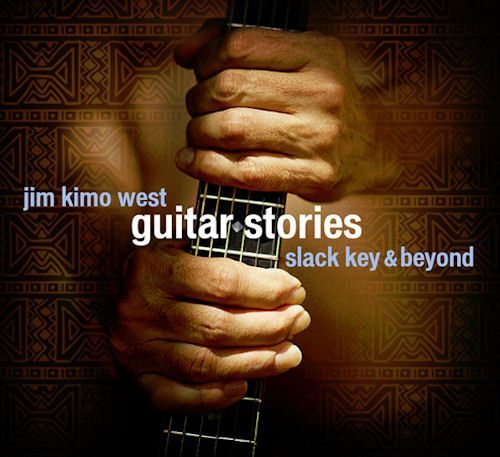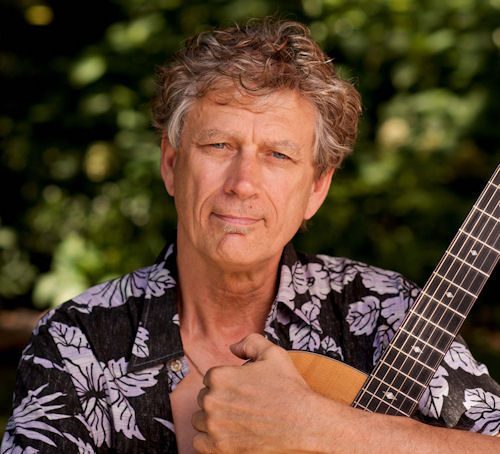JIM “KIMO” WEST – GUITAR STORIES
TITLE: GUITAR STORIES
ARTIST: JIM “KIMO” WEST
LABEL: WESTERNMOST RECORDS (673553000928)
RELEASE DATE: NOVEMBER 20, 2015
 From Maui to the mainland, Jim “Kimo” West has forged a reputation as a slack key guitar player worthy of kudos from Hawaiian masters of the open chord playing style based on dozens of mood-tinged tunings. George Kahumoku has invited him to play in the legendary Slack Key Show in Maui. West’s love and respect for Hawaiian culture comes through whether he is playing a coffeehouse gig or a festival. At the annual Slack Key Festival in Redondo Beach, CA, he tends to collaborate with other players in subtle but creative ways and then astonishes hushed audiences with his solo slack key compositions. His latest CD, Guitar Stories (subtitled Slack Key & Beyond) encompasses his technical fluidity and expressive qualities, applying them to compositions that aren’t typical Hawaiian slack key fare but are imbued with the soulfulness he has acquired from the genre on his life’s musical journey.
From Maui to the mainland, Jim “Kimo” West has forged a reputation as a slack key guitar player worthy of kudos from Hawaiian masters of the open chord playing style based on dozens of mood-tinged tunings. George Kahumoku has invited him to play in the legendary Slack Key Show in Maui. West’s love and respect for Hawaiian culture comes through whether he is playing a coffeehouse gig or a festival. At the annual Slack Key Festival in Redondo Beach, CA, he tends to collaborate with other players in subtle but creative ways and then astonishes hushed audiences with his solo slack key compositions. His latest CD, Guitar Stories (subtitled Slack Key & Beyond) encompasses his technical fluidity and expressive qualities, applying them to compositions that aren’t typical Hawaiian slack key fare but are imbued with the soulfulness he has acquired from the genre on his life’s musical journey.
 The nine tracks on this CD are inspired by places, events, people, and even objects that have touched his heart. Brief liner notes enrich the listening experience, showing slack key tunings he uses, instruments he has mastered, his production skills, and his flair for collaboration. Five of the tracks make reference to Hawaii. For openers, we hear the rich tones of the acoustic baritone guitar in a solo composition dedicated to koa, the richly colored wood, which comes from the Big Island and is often crafted into quality guitars and ‘ukuleles.
The nine tracks on this CD are inspired by places, events, people, and even objects that have touched his heart. Brief liner notes enrich the listening experience, showing slack key tunings he uses, instruments he has mastered, his production skills, and his flair for collaboration. Five of the tracks make reference to Hawaii. For openers, we hear the rich tones of the acoustic baritone guitar in a solo composition dedicated to koa, the richly colored wood, which comes from the Big Island and is often crafted into quality guitars and ‘ukuleles.
The second composition, Mauna Kea Meditation, brings to mind the piece by Keola Beamer that honors that same mountain’s snow goddess. But West makes it his own sacred tribute, using the Anuenue Tuning he invented (D A E F# A D) to combine with several musical layers. Simon Vitucci on cello and Erik Rynearson on viola bring a deeply flowing reflectiveness to the piece.
The Iolani Palace Waltz, Track Six, suggests the Victorian culture that Hawaiian royalty emulated in the latter part of the nineteenth century. The combination of Kimo’s acoustic guitar with a violin, viola, and cello resembles at times an elegant string quartet yet his use of the natural minor, his frequent emotive modulations and rolling crescendos and diminuendos paint add wistfulness to this portrait of a vanished era violated by American betrayal. In contrast, Mele Melehune, Track Eight, finds West a demonstrating his ability to be a one-man band, playing acoustic six and 12 string guitars, baritone acoustic guitar, steel guitar, percussion, and orchestral programming. He achieves other-worldly effects with this melange, very appropriate for a piece inspired by the legendary “little people” of Kaua’i.
One also hears influences from cultures other than Hawai’i and the USA. The third track, El Alcazar, explores the Moorish layer of culture that is still evident in Southern Spain with Middle Eastern motives and the inclusion of a dumbek, riq, and shakers. His exuberant Morning Music, Track Five, mimics the scales a West African kora would typically produce.
West’s eclecticism is on display in Daydream At Jumbo Rocks, a mood piece conjuring his California desert getaway spot in Joshua Tree National Park. On this fourth track, he plays the Moog guitar, an invention which has barely been in use for eight years; it allows him to sustain plucked notes and achieve a reverb effect that can’t be duplicated by post-production devices. In addition he plays acoustic steel guitar, and Gorky bottle. What! You haven’t heard of the Gorky bottle? You won’t find it in Grove’s Dictionary of Music. I emailed Kimo a query and he responded that it was a bottle he got from a now-vanished arty downtown coffee house called Gorky’s that used to give away merchandise. “One if the items I got was a plastic sports bottle with the Gorky’s logo (with Lenin’s face),” he wrote. “I found that by squeezing the bottle I could get this whistling sound in different pitches, depending on how hard I squeeze it. It’s just a quirky unusual sound and I had always wanted to use it on a recording.”
You learned it first from folkworks.org.
In sum, Guitar Stories is the work of a musician/composer who is writing an eloquent chapter in his musical life, experimenting with sounds and influences from Hawai’i and elsewhere. Above all, one senses that he is confident of his own mature voice.
Audrey Coleman is an ethnomusicologist, journalist and educator who explores traditional and world music developments in Southern California and beyond.













